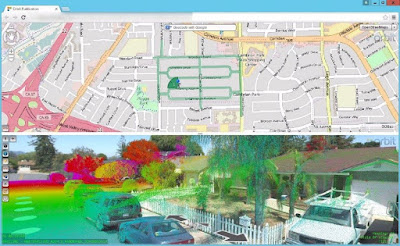Operating 4 Mobile LiDAR units (see Launching a Fleet) gives us the ability to be in many more places than ever before, but that’s only possible if there are LiDAR technicians available to transition the units from project to project. Even the most dedicated staff need a couple days off between long deployments; so needless to say, these trips were born out of necessity.
It’s been a little over 8 years since I’ve had the opportunity to do any field work, but it didn’t take long to get right back into the swing of things. Logistical efficiency is the name of the game. The more efficiently we perform on the work site and move between projects, the more projects we complete each deployment cycle, and the more cost savings we pass along to our clients. Think of it as “Just in Time” surveying.
Often overlooked and frequently taken for granted are the intricacies associated with the transition of field equipment/personnel between projects. The majority of people give no more consideration to a mobilization event than the time it takes to briefly consider the 1-2 day line-item on a project’s Gantt chart. In reality it’s a well-choreographed ballet of driver swaps, pit-stops, bio-breaks, traffic avoidance, and ad-hoc photo-ops.
Mobilizations are all about time-management. More aptly, it’s all about minimizing the loss of time. Speed limits and known construction sites establish the baseline for maneuvering from A-to-B. Accidents, thunderstorms, low overhead clearances, impromptu parades, flat tires, ice fog, volcanic events, presidential motorcades, and the occasional late night burrito lurk beyond every bend in the road looking for the opportunity to delay your arrival (and yes, I’ve encountered all of these, and many more in my day).
Don’t fool yourself into thinking that the drivers’ job is just a mindless exercise of maintaining 10-and-2 on the wheel and keeping it between the lines. Every delay, regardless of severity, and every spotted mile-marker evokes a seemingly-constant mental recalibration of the projected arrival time and the logistical changes that need to be coordinated.
Each and every time the vehicle stops you lengthen the amount of time you’ll be on the road that day. And with a 3-foot tall set of equipment strapped to the roof, there’s no options for the driver-thru. So each trip quickly reverts to a game of “how long can I wait”.
- Can the radio go loud-enough to drown-out the incessant squeaking/rattling coming from the toolbox that vibrated loose?
- Will the fumes in the tank get me to the travel plaza at the next exit that has a deli and a Dunkin Donuts, or do I pull over now at Mr. Bob’s Country Gulp-n-Guzzle with the slowest pumps known to man?
- Can I make it to the in-and-out convenience of the Rest Stop, and what are the chances it’s closed due to budgetary cutbacks?
Aaron
LiDAR Services Director








